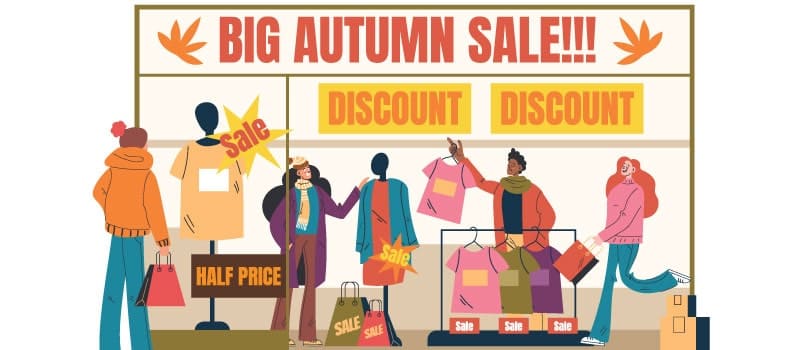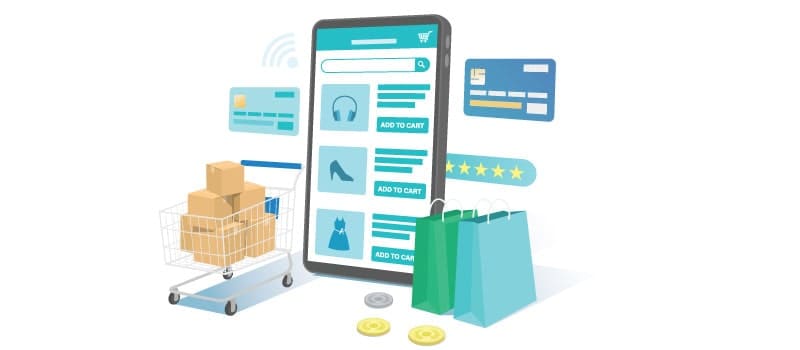In 1995, the first item that could be purchased online via Amazon was a book. Twenty years later, the eCommerce business and eCommerce trends have generated over 2 trillion US dollar sales across the globe. There’s no turning back now.
Ecommerce has revolutionized the retail industry. It has grown to meet the evolving requirements of customers and simplify shopping online for today’s customers. When it first began, eCommerce was reasonably limited in terms of its capabilities. However, this is no longer the case. In terms of customization, better return policies, or better integration, all of these innovations (among many other ones) have made eCommerce take the world in a storm. The year will revolutionize the world of eCommerce.
If you’re thinking about what the future holds for eCommerce, These eCommerce developments will show you that eCommerce isn’t only multiplying and staying. You can also incorporate these trends into your company to ensure steady growth for the online Shop you run.
To propel the success of your online business into the future, be sure you take advantage of these new trends that are emerging in the world of eCommerce. Don’t let someone else take over the job. Instead, hire yourself and call the shots.
Why are Ecommerce Trends So Important?
ECommerce is getting more competitive, and standing ahead of the game, eCommerce trends need to be monitored continuously. No matter how well-established your eCommerce site is today, you’ll be at a significant disadvantage if you’re not keeping up with eCommerce developments. Therefore, it is essential to look ahead to ensure success in the future.
It is necessary to be aware of these trends so that you can profit from these trends, and therefore it’s vital to ensure that eCommerce trends are evaluated and implemented on time. In this way, you will help your eCommerce brand grow and stay ahead of your competitors.
Top Ecommerce Trends
Are you thinking about what the next phase of eCommerce will look like? Are you looking at what eCommerce trends will affect the future that your website will enjoy? The following are the top 10 trends in eCommerce that you have to be aware of.
Read: 8 Steps to Starting Your eCommerce Store
Online Sales Growth is Unstoppable
The sales of e-commerce have increased continuously and for a good reason. Online shopping is among the most sought-after online activities. As a result, they expect worldwide eCommerce sales to rise 26.7 percent yearly to $4.891 trillion by 2021 (eMarketer 2021). And that isn’t all because they predict eCommerce sales to grow and eventually reach $6.388 trillion, nearly twice the amount of eCommerce’s total sales.

Although online shopping is among many of the most popular internet transactions, its use varies based on the region. With the rise of eCommerce stores, an increasing number of customers are going online for shopping. The increase in online shopping could be due to a variety of reasons. However, one of the primary reasons is the security that is offered to shoppers who shop online.
It also shows an increase in the number of trust buyers who purchase online have more confidence when buying on the internet and an enhanced experience on the website. In the past, consumers were reluctant to buy things on the internet, and that’s no longer the situation. Web sites have become more accommodating to customers. Along with the ease that it offers, it’s no doubt that sales growth on the internet is becoming inexplicably high.
Now buy web hosting for eCommerce for an efficient online store!
A New Era for Ecommerce Following COVID-19
One of the most considerable impacts, if not the largest, on eCommerce in 2020 is COVID-19.
As governments worldwide shut down stores and impose lockdowns that limit social movements for months at a time to fight the coronavirus, more and more people are turning towards the internet to buy products.
The e-commerce major, Amazon’s Jeff Bezos, has already seen his fortune grow by more than $24 billion because of the increased demand from customers for Amazon’s services and products.
Experts predict that the effects of the coronavirus won’t be just an immediate boost to commerce, but one that’s going to be around for a long time and will continue to be a factor even after COVID-19.
The reason is that consumers will become comfortable with the ease and convenience it brings and the advantages of using contactless payment methods. As a result, the benefits of contactless payment are likely to trigger an inevitable shift in behavior towards online purchases.
Analysts believe that the eCommerce sector will be one of the largest beneficiaries of this pandemic. They predicted permeation rates currently at fifteen percent to climb to 25 percent in 2025 (MarketWatch 2020) and this is the 67 percent growth within five years.
Unfortunately, the positive impact of COVID-19 on eCommerce is a massive loss for brick and mortar stores. Around 100,000 are expected to close in 5 years.
With about 24,000 closings, clothing retailers are most likely affected, followed by 12,000 consumer electronics stores and 11,000 home furnishings and grocery stores.
Mobile Shopping Has Been Increasing
The rapid growth of mobile commerce is very notable. In 2020, total sales made via mobile devices came in at $2.66 trillion. They project the figure to rise 18.8 percent to $3.16 trillion in 2019 before accelerating to $3.79 trillion by 2022 (Payvision 2020).
These numbers shouldn’t be overlooked. Making improvements to your eCommerce user experience on mobile users could be an enormous business opportunity to take advantage of.
The rise in use has fueled E-commerce growth partly by mobile phones because people aren’t shopping online anymore. They’re also using portable devices to browse and do some research before deciding on a purchase.
People’s trust in online shopping grows as consumers become more at ease shopping on mobile devices than before, and this is especially true for Millennials or Gen Z consumers. This is because technology and computers surround them. Generation Z is also more likely to shop online with their mobile devices compared to older generations.
With increasing numbers of websites now designed for mobile usage, make sure that your site and your online store are mobile-friendly. In this way, you’re making shopping more manageable and accessible to an even more significant number of customers.
Youth Consumers to Affect the Business Landscape
The effects of the coronavirus virus on the business world are undeniable. For example, nearly fifty percent (54 percent) of people increased their spending on the internet after the coronavirus outbreak.
However, even though this shift towards online shopping is apparent to people of all ages, younger people are accountable for the eCommerce movement.
Results from the survey revealed that two of three (67 percent) young people aged 18-34 are spending more on products online than they did before the pandemic (Shopify 2020).
The growth is slow for those in the more senior group of people. For example, the consumers between 35 and 54 years old have increased their spending on online shopping by 57 percent, whereas the figure is only 41 percent for people 55 and over.
However, moving forward as an eCommerce business owner, you must target the younger generations to boost your sales potential.
To do so, consider increasing your social media marketing efforts. Over half of the young customers who purchase from independent brands discover them through social media, which is more than any other group of age.
Evolving Function in the Social Media for Ecommerce
The number of people who shop on social media is booming. With the launch of the “Buy” button on Facebook and Instagram Checkout, social media plays a significant part in the world of eCommerce.
Social media has transformed how we live our lives. The way we shop presents a fantastic chance for companies to contemplate increasing their visibility with social networks. It can be an excellent platform for brands to gain attention. As more and more users spend time on various types of social media, eCommerce companies could benefit from the help of Instagram influencers to boost their chances of being noticed by their intended customers.
In addition, using platforms such as Shopify, companies can connect their online stores to social media websites to allow customers to purchase directly from them via social media. Instagram and Facebook, for instance, constantly update their features to meet the convenience requirements of buyers on the internet.
And who could not forget TikTok, the newest and most popular trend within the realm of online social networks that haven’t just entered the hearts of teenagers but as well in Hollywood?
The app that lets you share videos has been working to integrate eCommerce elements. The most recent developments include testing the new feature, which allows users to embed shoppable links on their profile pages or videos. Users who click this link are directed to the website within TikTok itself without needing to exit the app to access the website.
Social media platforms serve as a source of inspiration and give brands the chance to see people who go through their feeds. As social media grows to become an everyday aspect of our life, its ability to influence trends in eCommerce will only grow. That’s why companies must adopt a shopping-centric strategy for their social media strategies.
Environmental Topics Influence Buyers
Green consumer behavior is growing, and companies must act now. Nearly four out of ten online consumers believe that poor environmental credentials affect their buying decision-making (GlobalWebIndex 2020).
As an eCommerce website development company, you need to be striving to implement sustainable methods of operation. Today’s consumers are more conscious of their environment than they ever have before, and with the proper motives.
Businesses operating online must be proactive and ensure that their methods are environmentally green. This is a requirement for purchasing products from fair-trade companies to create a more sustainable online shopping environment.
The millennial generation is paving the way to more sustainable lifestyles of consumption. Be it free-range or organic skincare products, and there’s a growing need for brands to take a step towards attempting to protect our planet. Customers are feeling more responsible for their planet, which raises the obligation of brands to address the ecological needs of their consumers.
The Need To Shop at Smaller Businesses
Increasing numbers of shoppers buy online, but their buying habits and preferences for brands have also changed. With the increasing emphasis on sustainability and environmentally friendly practices aside, a growing percentage of customers are increasing their willingness to buy from independent businesses. Over fifty percent (57 percent) are looking to purchase from companies they haven’t heard of before (Shopify 2020).

The pandemic that afflicted many small businesses and encouraged people to buy from and support them has prompted the rise in support. As a result, over 1/3 (37 percent) of those who purchase from independent companies claim to do this more than they did before COVID-19.
One of the most interesting reasons to purchase from independent brands is the desire to encourage entrepreneurship that 33 percent of customers have as a reason. Other reasons include an interest in exclusive products (33 percent) and a positive experience with quality customer support (31 percentage).
Augmented Reality Transforms the Way We Shop
By 2022, over 120,000 retail stores will use Augmented Reality (AR) technologies providing a better shopping experience (Prnewswire 2018). People who work in retail and the online market will drive the growth of AR in the retail industry. One of the major problems customers face when purchasing online is that they cannot experience the item in person. AR technology bridges the gap and allows customers to see more clearly the things they are looking at.
For customers who shop online, this could be a game-changer. AR experiences can alter the way customers see the items they are planning to purchase. Using AR, customers will discern their requirements and determine if they plan to satisfy their needs. Certain eCommerce companies have already explored AR and AR technology, which can help to differentiate themselves from competitors. Offering more customized experiences to customers will enable an improved shopping experience online.
Businesses are using AR to enhance the experience for customers and allow shoppers to explore and test products the same way they would experience when shopping in person.
Personalization Will be the Future
Over 50% of customers believe that a customized online experience is essential (Bazaarvoice 2018). In addition, 74% of marketers believe that personalization can have a “strong” or “extreme” influence on improving customer relationships (Evergage 2018).
The ability to personalize the shopping experience is essential for keeping the customer’s content. Customers who shop online need help in finding the products they require and prefer a more personal experience. In addition, because of harmful recommendations for products, customers may avoid certain stores entirely.
ECommerce sites are in line with this trend and invest in personalization techniques to improve the shopping experience. They may do this through the personalization of emails that are sent out by email. It could also provide relevant information to the potential buyer group. Offering personalized customer communication, giving discounts pertinent to the customer, and engaging with customers through videos, for example, content can help provide the best shopping experience and increase the connection to your clients.
Visual Commerce is Growing
One of the biggest challenges of managing an eCommerce store is to market your product to people who don’t experience physical contact with your product. This is where the role of visual commerce is played.
In short, it is the next level of static images. It elevates marketing to a completely different degree because instead of using images of products to promote your company visually; it goes one step further by incorporating additional photos, such as user-generated media and interactive content, captivating videos, and, as mentioned, Augmented Reality.
Digital commerce, or visuals, is gradually but steadily becoming a part of online commerce, as evidenced by the growing popularity of the deep-learning technology used to create it.
This includes the market for image recognition that is expected to expand by $20.19 billion at the end of 2018 to $81.88 billion before 2026, a compound annual amount of 19.6 percent (MarketWatch 2020).
We have expected image recognition to be one of the most common within the North American market, in line with the growing popularity and the demand for visual content from US users. According to research, around 75 percent of internet consumers in the US are looking for visual content before making purchases frequently. However, a small percentage (3 percent) don’t.
Artificial Intelligence (AI)
For ecommerce stores in terms of automating and personalizing their stores, segmenting customers and identifying patterns are major challenges. To deal with such challenges, intelligent algorithms are now hailed as the key.6% to 10% of sales are gained by retailers who adopt personalization strategies, according to Business Insider..
Data quality and size greatly influence the accuracy of data. Having a small amount of data can cause challenges for small ecommerce businesses. This restriction can be worked around by partnering with third party providers. AI powered tools are expected to be used by more companies in the future.
Conclusion
With the development of technology and the shift in consumer habits, it is essential to be on the lookout for these trends. Whatever eCommerce style you decide to go with (check for this listing of eCommerce website builders), are you planning to enhance your customers’ shopping experience and build lasting relationships with them? Let your eCommerce evolve to the next level by advancing with it side-by-side and leveraging the latest trends in eCommerce.















